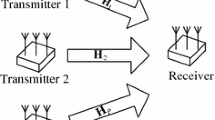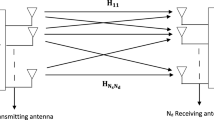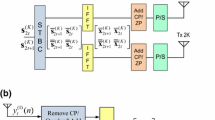Abstract
A novel blind channel estimation algorithm, based on fourth-order cumulant matrices, is proposed and applied to linear Space–Time Block Coded (STBC) for Multiple Input Multiple Output systems. Contrary to subspace and Second-Order Statistics (SOS) methods, the presented approach estimates the channel matrix without any modification of the transmitter. It takes advantage of the statistical independence of the signals in front of the space–time encoding. In this paper, the presented algorithm estimates the channel matrix by minimizing a cost function based on the higher cumulant matrices after Zero-Forcing equalization to mitigate the computational complexity and improve the performance. We employ the proposed method to the STBC systems including Spatial Multiplexing, Orthogonal, quasi-Orthogonal and Non-Orthogonal STBC systems. Symbol error rate and Normalized Mean Square Error simulations of the proposed algorithm are shown for a different number of users, signal to noise ratios and different number of symbols per user in comparison with subspace and Second-Order Statistics (SOS) methods. The results show that the presented method performs well and outperforms other methods in estimating the channel matrix from the received data. Moreover, the proposed method presents high convergence speed in estimating the channel matrix.








Similar content being viewed by others
References
Alamouti, S. (1998). A simple transmit diversity technique for wireless communication. IEEE Journal on Selected Areas in Communications, 16(8), 1451–1458.
Jafarkhani, H. (2005). Space-time coding: Theory and practice. Cambridge: Cambridge University Press.
Ammar, N., & Ding, Z. (2006). Channel identiability under orthogonal spacetime coded modulations without training. IEEE Transactions on Wireless Communications, 5(5), 1003–1013.
Guowei, L., Yuanan, L., & Xuefang, X. (2016). Effect of imperfect CSI on STBC-MISO system via antenna selection. IET Signal Processing, 10(2), 115–124.
Swindlehurst, A., & Leus, G. (2002). Blind and semi-blind equalization for generalized spacetime block codes. IEEE Transactions on Signal Processing, 50(10), 2489–2498.
Shahbazpanahi, S., Gershman, A., & Manton, J. (2005). Closed form blind MIMO channel estimation for orthogonal space-time codes. IEEE Transactions on Signal Processing, 53(12), 4506–4517.
Via, J., & Santamaria, I. (2008). On the blind identiability of orthogonal space time block codes from second order statistics. IEEE Transactions on Information Theory, 54(2), 709–722.
Abrudan, T., Eriksson, J., & Koivunen, V. (2008). Steepest descent algorithms for optimization under unitary matrix constraint. IEEE Transactions on Signal Processing, 56(3), 1134–1147.
Via, J., Santamaria, I., & Perez, J. (2009). Code combination for blind channel estimation in general MIMO-STBC systems. EURASIP Journal on Advances in Signal Processing. 2009, 3. https://doi.org/10.1155/2009/103483.
Larsson, E., Stoica, P., & Li, J. (2002). On maximum-likelihood detection and decoding for space-time coding systems. IEEE Transactions on Signal Processing, 50(4), 937–944.
Ma, W., Vo, B., Davidson, T., & Ching, P. (2006). Blind ML detection of orthogonal space-time block codes: Efficient high-performance implementations. IEEE Transactions on Signal Processing, 54(2), 738–751.
Gallo, A., Chiavaccini, E., Muratori, F., & Vitetta, G. (2004). BEM-based SISO detection of orthogonal space-time block codes over frequency at fading channels. IEEE Transactions on Wireless Communications, 3(6), 1885–1889.
Li, Y., Georghiades, C., & Huang, G. (2001). Iterative maximum likelihood sequence estimation for space-time coded systems. IEEE Transactions on Communications, 49(6), 948–951.
Ammar, N., & Ding, Z. (2007). Blind channel identi ability for generic linear spacetime block codes. IEEE Transactions on Signal Processing, 55(1), 202–217.
Jafarkhani, H. (2001). A quasi-orthogonal space-time block code. IEEE Transactions on Communications, 49(1), 1–4.
Eldemerdash, Y. A., Dobre, O. A., & Öner, M. (2016). Signal identification for multiple-antenna wireless systems: Achievements and challenges. IEEE Communications Surveys and Tutorials, 18(3), 1524–1551.
Choqueuse, V., Mansour, A., Burel, G., Collin, L., & Yao, K. (2011). Blind channel estimation for STBC systems using higher-order statistics. IEEE Transactions on wireless Communications, 10(2), 495–505.
Boarui, A., & Ionescu, D. (2003). A class of nonorthogonal rate-one spacetime block codes with controlled interference. IEEE Transactions on Wireless Communications, 2(2), 270–276.
Acar, Y., Doan, H., Baar, E., & Panayirci, E. (2016). Interpolation based pilot-aided channel estimation for STBC spatial modulation and performance analysis under imperfect CSI. IET Communications, 10(14), 1820–1828.
Dapena, A., Prez-Iglesias, H. J., & Zarzoso, V. (2012). Blind channel estimation based on maximizing the eigenvalue spread of cumulant matrices in 2 1 Alamoutis coding schemes. Wireless Communications and Mobile Computing, 12(6), 516–528.
Gao, J., Zhu, X., & Nandi, A. K. (2011). Independent component analysis for multiple-input multiple-output wireless communication systems. Signal Processing, 91(4), 607–623.
Abrudan, T. E., Eriksson, J., & Koivunen, V. (2008). Steepest descent algorithms for optimization under unitary matrix constraint. IEEE Transactions on Signal Processing, 56(3), 1134–1147.
Guobing, Q., Li, L., & Luo, M. (2014). On the blind channel identi ability of MIMO-STBC systems using noncircular complex FastICA algorithm. Circuits System Signal Processing, 33, 1859–1881.
Cardoso, J., & Soloumiac, A. (1993). Blind beamforming for non-Gaussian signals. IEE proceedings F, 140(46), 362–370.
Luo, M., Li, L., Qian, G., & Liao, H. (2014). Multidimensional blind separation using higher-order statistics: Application to non-cooperative STBC systems. Circuits System Signal Processing, 33, 2173–2192.
Albataineh, Z., & Salem, F. M. (2016). Adaptive blind CDMA receivers based on ICA filtered structures. Circuits, Systems, and Signal Processing. https://doi.org/10.1007/s00034-016-0459-4.
Albataineh, Z., & Salem, F. (2015). Robust blind multiuser detection algorithm using fourth-order cumulant matrices. Circuits, Systems, and Signal Processing, 34, 2577–2595.
Beres, E., & Adve, R. (2007). Blind channel estimation for orthogonal STBC in MISO systems. IEEE Transactions on Vehicular Technology, 56(4), 2042–2050.
Comon, P., & Jutten, C. (Eds.). (2010). Handbook of blind source separation independent component analysis and applications. Oxford: Academic Press.
Cardoso, J.-F. (1999). High-order contrasts for independent component analysis. Neural Computation, 11(1), 157–192.
Marey, M., & Dobre, O. A. (2017). Automatic identification of space-frequency block coding for OFDM systems. IEEE Transactions on Wireless Communications, 16(1), 117–128.
Zhang, B., Yu, J. L., Yuan, Y., et al. (2016). Fast blind channel estimation for space-time block coded MIMO-OFDM systems. Telecommunication Systems. https://doi.org/10.1007/s11235-016-0244-5.
Xianhua, L., Cardoso, J.-F., & Randall, R. B. (2010). Very fast blind source separation by signal to noise ratio based stopping threshold for the SHIBBS/SJAD algorithm. Mechanical Systems and Signal Processing, 24(7), 2096–2103.
Liu, X., & Randall, R. B. (2005). A new efficient independent component algorithm: Joint approximate diagonalization of simplified cumulant matrices. In The 16th national congress of Australian institute of physics, Canberra, Australia.
Cardoso, F. (1994). On the performance of orthogonal source separation algorithms. In Proceedings of the EUSIPCO (pp. 776–779).
Manton, J. (2004). Optimization algorithms exploiting unitary constraints. IEEE Transactions on Signal Processing, 50(3), 635–650.
Tarokh, V., Jafarkhani, H., & Calderbank, A. (1999). Spacetime block coding for wireless communications: Performance results. IEEE Journal on Selected Areas in Communications., 17(3), 451–460.
Author information
Authors and Affiliations
Corresponding author
Rights and permissions
About this article
Cite this article
Albataineh, Z. Robust blind channel estimation algorithm for linear STBC systems using fourth order cumulant matrices. Telecommun Syst 68, 573–582 (2018). https://doi.org/10.1007/s11235-017-0410-4
Published:
Issue Date:
DOI: https://doi.org/10.1007/s11235-017-0410-4




